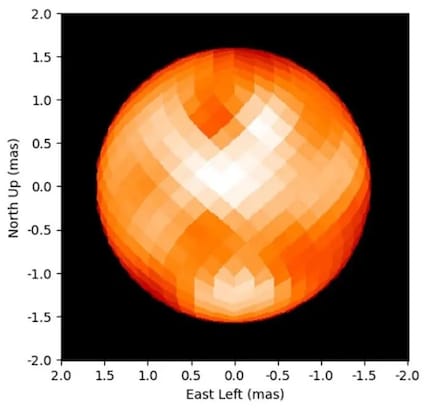
The North Star has spots
Using the CHARA telescope array on Mount Wilson, it was possible to visualise dark spots on Polaris. It was also possible to observe its close companion.
For 120 years, there has been an observatory on Mount Wilson, located on the eastern outskirts of the Californian metropolis of Los Angeles. It is most famous for the 2.5 metre Hooker telescope, which was the largest telescope in the world for three decades. But Mount Wilson is also home to a large number of other instruments, including the CHARA telescope network. The abbreviation stands for the Center for High Angular Resolution Astronomy and refers to a combination of six 1-metre telescopes which, when connected together, achieve the spatial resolution of a 330-metre telescope. Using this system, an interferometer, a team led by Nancy Remage Evans from the Harvard-Smithsonian Astrophysical Observatory has now succeeded in spatially resolving the surface of the polar star with milliarcsecond precision and revealing details of the surface of this giant star. A milliarcsecond is the 1000th part of a second of arc, which in turn is the 3600th part of a degree.
The CHARA images show dark spots on Polaris, which are related to its stellar activity and magnetic field. In relation to Polaris, the full moon appears 600,000 times larger in the sky, which is an enormous achievement for CHARA. Polaris is a giant star with 5.13 times the mass of our sun and 46 times the diameter of our central star. If placed in our solar system, Polaris would be close to the orbit of the innermost planet Mercury. With a visual magnitude of 2 mag, it is easy to see in the sky and marks the northern celestial pole quite precisely.

Source: © Georgia State University, Center for High Angular Resolution Astronomy / CHARA Array (detail)
Polarstern is part of a triple star system and is known as Polaris Aa; its companion Polaris B was discovered by Wilhelm Herschel in 1779. Polaris Aa is accompanied by a faint star called Polaris Ab, which takes around 30 years to complete one orbit. This has now been confirmed with the observations from CHARA, which has determined its orbit around the main star more precisely.
Polarstern is a regularly variable star of the Cepheid type, whose luminosity fluctuates with a period of four days. Cepheids are named after their prototype Delta Cephii in the constellation Cepheus and are suitable for calibrating cosmic distances because their absolute luminosity depends on the period: the distance between Earth and the star can be derived from the comparison between absolute and measured luminosity in the sky.
Spectrum of Science
We are a partner of Spektrum der Wissenschaft and want to make well-founded information more accessible to you. Follow Spektrum der Wissenschaft if you like the articles.
Original article on Spektrum.deExperts from science and research report on the latest findings in their fields – competent, authentic and comprehensible.